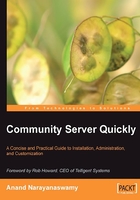
What This Book Covers
The Community Server platform is introduced in Chapter 1 and we look into the evolution of Community Server and various applications available with it. Keeping in mind the nature of tasks that lie ahead, this chapter also discusses various editions and licensing options that will help you to choose the right Community Server platform for your use. Finally it outlines some of the key features of the upcoming Community Server 3.0.
Everything that you require to execute Community Server on a development machine is discussed in Chapter 2. The steps required for download and installation of Community Server are explained in depth. The chapter also lists the steps required to configure your installation and describes the various options found in the Control Panel.
One of the greatest features available with Community Server, blogs, is explored in Chapter 3. It examines how to create and manage blogs to publish content with the help of a sample blog. It also explains how to configure blogs for registered users.
Community Server has a fully featured discussion forum. Chapter 4 teaches you how to create forum groups so that you can file each forum under the appropriate group and create a sample forum. After creating forums the chapter covers making posts and also how to manage and administer these forums.
Chapter 5 shows you how to add a gallery to your Community Server. You will learn how to create photo and file galleries and manage them with the help of sample photo and file galleries.
Chapter 6 explains the powerful reader and roller features of Community Server. By implementing reader and roller functionality in your site, you can keep track of content of the other blogs using RSS feeds.
Chapter 7 looks at management of site members, their profiles, resetting passwords, and managing roles, cookies, and avatar settings.
The standard look and feel of Community Server gets a face-lift in Chapter 8. It gives you a run down of how attractive Community Server can be through the use of themes and also explains how to make important modifications to your chosen theme. It also teaches you how to use add-ons and modules, and to include custom links in the navigation bar of the site.
Chapter 9 gives you the edge when it comes to managing various Community Server settings. It explains the management of different settings associated with RSS, post, date, time, and email. At the end of the chapter you learn how to track the IP addresses of visitors to your Community Server site.
Chapter 10 takes you one step further by looking at the reporting functionality. This chapter shows you how an administrator can generate and view not only user, blog, and forum activity reports but also different types of exceptions and jobs reports.
Chapter 11 delves into monetizing your site by advertising through Google AdSense and Amazon affiliate programs. It further discusses the management of licenses, word filters, spam blocker, member points, emoticons, and IP addresses.
Appendix A walks through the steps followed for deploying Community Server to a hosted server. Basically it provides a sound process for taking the finished product and making it available for public consumption on your host site.